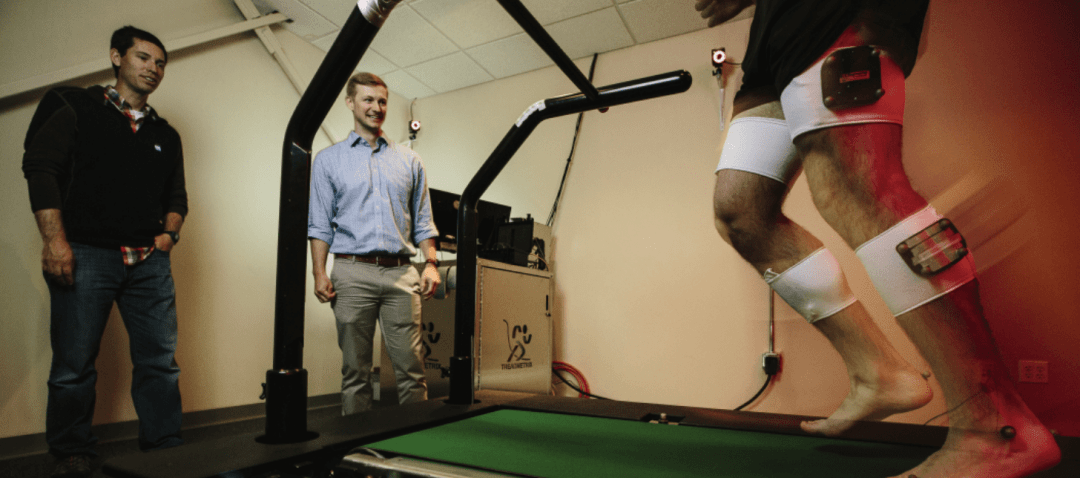Montana State biomechanics researcher featured in Washington Post story
Tuesday Mar. 14th, 2023

Scott Monfort, middle, with Jim Becker, left, conducting research in MSU's Neuromuscular Biomechanics Lab. MSU photo by Adrian Sanchez-Gonzalez
BOZEMAN — A Montana State University researcher whose work is focused on reducing knee injuries and improving rehabilitation was recently featured in The Washington Post.
The Feb. 27 article, “Researchers are exploring how the brain helps prevent knee injuries,” extensively quotes Scott Monfort, co-director of MSU’s Neuromuscular Biomechanics Laboratory, and cites two recent papers he co-authored.
The article summarizes recent findings about the role that cognitive processes play in the risk and incidence of knee injuries. According to the story, roughly 200,000 people in the U.S. strain or tear the anterior cruciate ligament, or ACL, in their knee each year, and Monfort’s research is at the forefront of understanding new ways those injuries can be prevented and recovery from them.
“It’s becoming increasingly clear that how people mentally process the environment around them can affect their risk of sustaining a musculoskeletal injury,” Monfort said in a recent interview. “Understanding that allows us to develop new and more effective screening tools and training and rehabilitation methods.”
The basic explanation that’s emerging is that when cognitive process are stressed — such as when a soccer player is processing the movement of players around them and making quick decisions about the game — the brain has added difficulty planning safe and effective movements in the split second before a ligament is strained or torn, said Monfort, assistant professor in the Department of Mechanical and Industrial Engineering in MSU’s Norm Asbjornson College of Engineering.
One of Monfort’s papers cited in the story and originally published in 2019 in the American Journal of Sports Medicine measured cognitive factors related to risky knee movements — in which the leg bends sideways at angles approaching the point at which a ligament strain or tear could occur — in 15 collegiate club soccer players. Monfort and his collaborators used specialized cameras to track leg movements while the players conducted movement exercises, including some that involved concentrating on the task of dribbling a soccer ball. Separate tests were used to measure the players’ cognitive abilities, including visual memory and reaction time. The researchers found that participants with the worst visual-spatial memory had the largest increase in risky knee movement when they had to move while also dribbling the ball.
In another study, published last fall, Monfort and his co-authors measured single-leg balance among athletes who were recovering from ACL injury and found distinct differences in balance control compared to the control group when a cognitive challenge was added during the balance task. That study further reiterates the potential for cognitive interventions to reveal lingering neuromuscular impairments after injury, he said.
Currently, Monfort is leading a project funded by $300,000 from the National Institutes of Health that’s aimed at refining understanding of how integrating cognitive tasks into rehabilitation exercises could improve recovery of ACL injuries. The project is co-led at MSU by Keith Hutchison, professor in the Department of Psychology in MSU’s College of Letters and Science, and James Becker, associate professor in the Department of Health and Human Development in MSU’s College of Education, Health and Human Development, who co-directs the biomechanics lab with Monfort. The study also includes Ohio University researchers Janet Simon and Dustin Grooms, who was also quoted in the story in The Washington Post.
The MSU Neuromuscular Biomechanics Laboratory is equipped with sensors in the floor and specialized cameras that can track and measure participants’ motions. The lab also has devices to measure participants’ strength and even how certain parts of the brain are activated during tasks.
“We have an interdisciplinary research group and a unique facility that allows us to explore some of these new frontiers of injury prevention and rehabilitation,” Monfort said. “This is a great place to work on this and an exciting time to be working in a growing research area.”
“Our vision is to take what we’re doing and make a positive impact on injury prevention and rehabilitation,” Monfort said.
| Tweet |